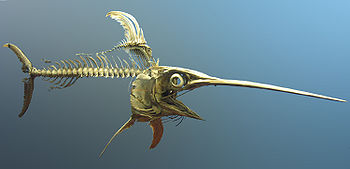
Endoskeleton
Encyclopedia

Animal
Animals are a major group of multicellular, eukaryotic organisms of the kingdom Animalia or Metazoa. Their body plan eventually becomes fixed as they develop, although some undergo a process of metamorphosis later on in their life. Most animals are motile, meaning they can move spontaneously and...
, composed of mineralized tissue
Mineralized tissues
Mineralized tissues are biological tissues that incorporate minerals into soft matrices. Typically these tissues form a protective shield or structural support...
. Endoskeleton develops within the skin or in the deeper body tissues. The vertebrate is basically an endoskeleton made up of two types of tissues (bone and cartilage). During early embryonic development the endoskeleton is composed of notochord
Notochord
The notochord is a flexible, rod-shaped body found in embryos of all chordates. It is composed of cells derived from the mesoderm and defines the primitive axis of the embryo. In some chordates, it persists throughout life as the main axial support of the body, while in most vertebrates it becomes...
and cartilage
Cartilage
Cartilage is a flexible connective tissue found in many areas in the bodies of humans and other animals, including the joints between bones, the rib cage, the ear, the nose, the elbow, the knee, the ankle, the bronchial tubes and the intervertebral discs...
. The notochord in most vertebrates is replaced by vertebral column and cartilage is replaced by bone in most adults.In three phyla
Phylum
In biology, a phylum The term was coined by Georges Cuvier from Greek φῦλον phylon, "race, stock," related to φυλή phyle, "tribe, clan." is a taxonomic rank below kingdom and above class. "Phylum" is equivalent to the botanical term division....
and one subclass
Class (biology)
In biological classification, class is* a taxonomic rank. Other well-known ranks are life, domain, kingdom, phylum, order, family, genus, and species, with class fitting between phylum and order...
of animals, endoskeletons of various complexity are found: Chordata, Echinoderm
Echinoderm
Echinoderms are a phylum of marine animals. Echinoderms are found at every ocean depth, from the intertidal zone to the abyssal zone....
ata, Porifera, and Coleoidea
Coleoidea
Subclass Coleoidea, or Dibranchiata, is the grouping of cephalopods containing all the primarily soft-bodied creatures. Unlike its sister group Nautiloidea, whose members have a rigid outer shell for protection, the coleoids have at most an internal bone or shell that is used for buoyancy or support...
. An endoskeleton may function purely for support (as in the case of sponges), but often serves as an attachment site for muscle and a mechanism for transmitting muscular forces. A true endoskeleton is derived from mesodermal tissue. Such a skeleton
Skeleton
The skeleton is the body part that forms the supporting structure of an organism. There are two different skeletal types: the exoskeleton, which is the stable outer shell of an organism, and the endoskeleton, which forms the support structure inside the body.In a figurative sense, skeleton can...
is present in echinoderms and chordates. The poriferan 'skeleton' consists of microscopic calcareous or siliceous spicule
Spicule
Spicules are tiny spike-like structures of diverse origin and function found in many organisms, such as the copulatory spicules of certain nematodes or the grains on the skin of some frogs.In sponges, spicules perform a structural function....
s or a spongin
Spongin
Spongin, a modified type of collagen protein, forms the fibrous skeleton of most organisms among the phylum Porifera, the sponges. They are secreted by sponge cells known as spongocytes...
network. The Coleoidae do not have a true endoskeleton in the evolutionary sense; here, a mollusc exoskeleton
Exoskeleton
An exoskeleton is the external skeleton that supports and protects an animal's body, in contrast to the internal skeleton of, for example, a human. In popular usage, some of the larger kinds of exoskeletons are known as "shells". Examples of exoskeleton animals include insects such as grasshoppers...
evolved
Evolution
Evolution is any change across successive generations in the heritable characteristics of biological populations. Evolutionary processes give rise to diversity at every level of biological organisation, including species, individual organisms and molecules such as DNA and proteins.Life on Earth...
into several sorts of internal structure, the "cuttlebone" of cuttlefish
Cuttlefish
Cuttlefish are marine animals of the order Sepiida. They belong to the class Cephalopoda . Despite their name, cuttlefish are not fish but molluscs....
being the best-known version. Yet they do have cartilaginous tissue in their body, even if it is not mineralized, especially in the head, where it forms a primitive cranium.The endoskeleton gives shape,support and protection to the body and provides a mean of locomotion.

